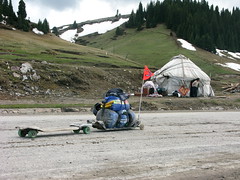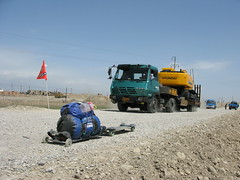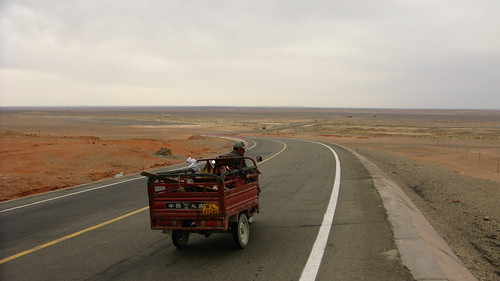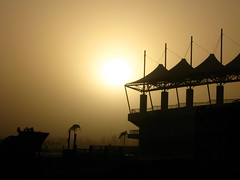Route Information Sheet for Longboard Touring in Xinjiang Province, China
This route information sheet describes a 1,275km month-long tour of China’s northewestern province of Xinjiang. Route info sheet prepared by Rob Thomson.
Essential details:
Location: Xinjiang Province, China
Route distance: 1,275km (790 miles)
Start: Kazakhstan border at Khorgos
Finish: Gansu Province border at Xinxinxia Pass
Road surfaces: 95% smooth asphalt, 5% loose gravel
Highway name(s): China National Highway G312
Difficulty*: 5
* Scale: 1 – Enjoyable afternoon skate // 3 – Moderate overnighter // 5 – Extremely challenging multi-day skating expedition
Xinjiang: The land of the Uyghurs
You could be excused for being a little confused when you arrive in Xinjiang Province. As you skate the streets in towns such as Urumqi, Turpan and Hami, you will see many non-Asian faces. The Uyghur people outnumber the Han Chinese population here slightly, although this is likely to change as more Chinese move to the region for work. The Uyghur population is predominantly Muslim, and their nomadic culture permeates life in Xinjiang, with their Persian-Arab influenced culture and Turkic language adding to the already colourful Silk Road heritage that this route encompasses. Xinjiang is not at all the image of China that a westerner typically has. Skating along this route, there are camels, women wearing head scarfs, wide open remote areas, and a very low population density.
Terrain
Xinjiang is an area of rugged mountains and vast desert basins, and starting in the east on the border with Kazakhstan, this route begins with a challenging climb from altitude 700m at the border town of Khorgos to a pass at 2,200m (the route’s highest point) at the small settlement of Santai, all within 120km of the border. Upon passing the picturesque Lake Sarym and descending the phenomenal 35km downhill from the pass to altitude 350m (on an almost traffic-free, super smooth expressway), the route flattens out and there are no more steep road passes until the end at Xinxinxia Pass on the border with Gansu Province. The desert terrain can be deceiving however, and over the course of the 500km to Urumqi the highway gains 700m in altitude to finish at 1,000m at Urumqi.
Likewise, the route continues for the remaining 750km gaining and losing altitude extremely gradually in both cases, mostly between 1,000m and 1,800m in altitude. The only exception is a conspicuous drop to more than 100m below sea level at the beautiful Silk Road city of Turpan. Long gradual uphills can make for psychologically draining days, as does the often featureless, arid and dry surroundings of the Gobi Desert east of Urumqi.
Crossing the southwestern-most edge of this massive desert, wind will be the skater’s biggest foe. There is always wind, it is always strong, and it comes from all directions. Side winds from the north can be especially strong, often to the extent of halting progress altogether.
Road surfaces
As is the case in most of China, any major highway is extremely well maintained, and National Highway G312 is no exception. Major construction is taking place all along the route, where a new super-expressway is being built. As the expressway takes shape, over the next five years there will be short sections of G312 that will be either diverted or under construction. In the worst case, these under construction sections will consist of loose gravel that is impossible to skate on, however if these sections are further than 500m long, they are typically paved roughly with chipseal.
On the other hand, there will be sections of newly paved expressway that is not yet open to traffic, but can be easily accessed by foot. These can be many tens of kilometres long, and provide a welcome break from the regular truck traffic on the main route.
For the most part however, skaters can expect excellent skating surfaces.
Traffic
Private car ownership in China is still confined predominantly to the very wealthy, so therefore the vast majority of traffic on the roads is trucks, buses, and taxis. As is the case in most countries, professional drivers are very accommodating to a human powered traveller, and in China will give you as much room as they can. Human powered traffic is very common in China, so drivers are already attuned to fact that they are not the only users of the road.
It is worth noting that everywhere in China, drivers use their horns with astounding and somewhat annoying frequency. They will honk when overtaking, honk when being overtaken, honk when they think they will be overtaken, honk when they want to let you know they are behind you, honk to let you know they are approaching you. Due to the fact that a person travelling by skateboard is an anomaly of massive proportions in China, they will also honk to get your attention and honk to show their approval.
Climate
Temperatures range from -20 degrees Celsius in the winter months of November to February, to over 45 degrees Celsius in the summer months of June, July and August. The best time to enjoy this route is in the spring or autumn. Xinjiang province has an annual mean rainfall of 150mm, so is extremely dry.
Logistics
From the the border at Khorgos to the large metropolis of Urumqi, there are regular services, no more than 30km apart at the most. Water is available along the route either bottled (do not count on getting anything other than 600ml bottles) or boiled water from restaurants, gas stations and road-side stalls. Drinking water directly from facets or streams without treatment is not recommended, as it often causes diarrhoea, and in some cases Giardia and amoebic dysentery.
East of Urumqi, the reason for this route being described as ‘extremely challenging’ becomes apparent; there are large mileages between services, there is a lack of water, the temperatures are extreme and extreme headwinds and sidewinds can halt progress completely. Hence careful and experienced planning is required.
Apart from some large towns such as Turpan and Hami, there is only a scattering of small towns along the route, with the longest stretch between services being 140km, between Lotojue (65km east of Hami) and Xinxinxia Pass. It is not unusual to skate 50km or more between services. There is however regular truck traffic, as well as road maintenance/construction camps (as of June 2008) that could provide water if absolutely necessary.
Wild camping is possible everywhere along the route, the exception being in cities. There is cheap accommodation in cities however, and there is no need to pay anything more than 6 Euro for a room, and in most cases less than 3 Euro will get you a single room. Reservations are not required. The cheap accommodation will usually not have an ensuite bathroom, and the toilets will test your ability to hold your breath – they stink.
In Urumqi, there are two international youth hostels where you’re guaranteed to meet other international travellers. In Turpan, the best value place to stay is the Transport Hotel at the bus center on Laocheng Road. A bed in a dorm room with other international travellers is about 2.5 Euro. In Hami and other towns, you’re on your own, but you’ve got a plethora of choices.
There are no dedicated skate shops along this entire route, although in Urumqi, Turpan, and Hami there are small stores selling children’s scooters where bearings can be bought. Likewise, there are many small hardware stores in most small towns that stock bolts and nuts. Do not count on getting skateboard wheels any larger than 55mm (short board wheels) anywhere in China. The nearest store stocking trucks (Independent longboard trucks) and good quality bearings is Funboxx in Shanghai, 4,500km away.
Bureaucracy
To travel in China, most foreign nationals require a Chinese visa. Chinese visa regulations change on an almost daily basis, and it is recommended to check with your nearest Chinese Embassy or consulate well in advance of your planned departure date as to the current regulations. At the very least most western nationals should be able to get a 30 day tourist visa (L visa) at their nearest Chinese Embassy or consulate with little problems, no questions asked. Tourist visas can be extended easily within China for a small fee (16 Euro) for 30 days at a time, up to two times.
If regulations allow, apply for a 60 or 90-day Tourist visa in your home country, as this will allow you more time without the hassle of extending. If skating the full 1,275km route, it will easily take one month including stops to explore cities.
Time Zone
Xinjiang operates on two separate time ‘zones’. The official time zone is Bejing time, which is two hours later than local time. If it is 9am Beijing time, it is 7am local time. Beijing time is UTC/GMT +8 hours, and Xinjiang time is UTC/GMT +6 hours.
Getting There and Away
If starting in the west at Khorgos, there are weekly direct train services from Shanghai and Beijing to Urumqi. From Urumqi, you can catch one of the daily buses running to the border at Khorgos. The train from Beijing takes approximately 50 hours, as does the train from Shanghai. A hard sleeper ticket for the train is the best value at around 60 Euro for the 4,000km train ride. The overnight sleeper bus from Urumqi is around 15 Euro, and takes 12 hours to cover the 650km to Khorgos. There are also flights to Urumqi from Beijing, however these are expensive and the train ride is worth the experience.
Xinxinxia is more or less in the middle of nowhere. It should be possible to get a bus back to Hami however, or more practically, onwards east to the next big city, which is Guazhou in Gansu Province. From Guazhou, there are regular sleeper bus services to Lanzhou. If you have time, the onward skate along National Highway G312 to Guazhou passes through some interesting semi-arid terrain that is quite different from the life-less desert of Xinjiang.
Alternate trip options
This route ends at Xinxinxia Pass, which is, by all accounts, in the middle of nowhere. If you just want to experience some good challenging desert skating, then consider the following shorter options:
Urumqi to Hami
This is pure desert skating through and through. A 450km skate on smooth highways across part of the massive Gobi Desert. Massive endless flat, gradual ascending and gradual descending terrain punctuated by oasis towns such as Turpan with classic Silk Road culture and Shanshan with its massive red-sand sand dunes. Points of interest include the Flaming Mountains, local Uyghur culture, the Ancient City of Gaochang (10km off route), and of course Turpan. Extremely efficient long distance buses will get you from Hami back to Urumqi, or from Hami to Lanzhou, where you can get a train back to the east of China
Urumqi to Turpan
This 220km three-day skate, which is part of the main route described in this article, captures something of everything that you’ll see on the full route. Narrow rocky gorges, desolate open stony plains, green oasis pastures, Silk Road culture, Uyghur culture, camels…
Beware: Both of these shorter options are also susceptible to the extreme desert conditions outlined in the main route description, as well as long distances between services.
Other resources:
- Rob Thomson’s online journal with photos from this route starts from Day 646 on his longboard travel blog.
- Videos from this route:
- Heather Burge’s cycle blog – Heather cycled part of this route east to west from Xinxinxia Pass to Urumqi, and has very detailed information on services on the route. Her coverage of the route begins here.




















